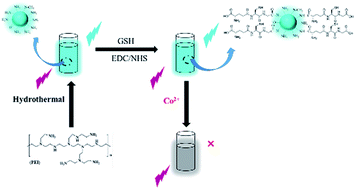Fluorescent carbon dots directly derived from polyethyleneimine and their application for the detection of Co2+†
Abstract
In this paper, polyethyleneimine (PEI) was applied as a carbon source for synthesizing fluorescent carbon dots (CDs) through a facile and one-step hydrothermal route. Both the N-doping and the amino-functionalization of CDs were accomplished simultaneously. The CDs exhibited strong blue fluorescence and good dispersion in aqueous solution. A large number of amino groups on the surface of CDs greatly simplified the subsequent modification steps. Through an amide reaction, glutathione-functionalized CDs were successfully applied to the selective detection of Co2+, in the linear range from 2.0 × 10−5 to 1.0 × 10−4 mol L−1.

- This article is part of the themed collection: Analytical Methods Recent HOT articles


 Please wait while we load your content...
Please wait while we load your content...